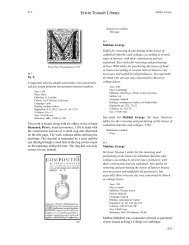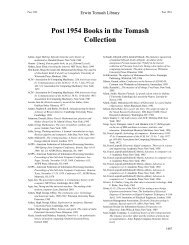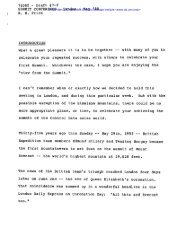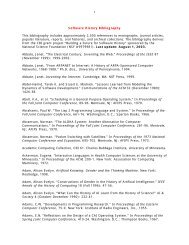B chapter.indd - Charles Babbage Institute - University of Minnesota
B chapter.indd - Charles Babbage Institute - University of Minnesota
B chapter.indd - Charles Babbage Institute - University of Minnesota
You also want an ePaper? Increase the reach of your titles
YUMPU automatically turns print PDFs into web optimized ePapers that Google loves.
at the ends <strong>of</strong> the scale but near the middle, a situation<br />
that lessens the amount the slide has to move in many<br />
calculations.<br />
This is a large work on the use <strong>of</strong> a special slide rule<br />
created by Auguste Beghin in 1898. The instructions are<br />
illustrated with seventy-four problems and 135 figures.<br />
128<br />
Illustrations available:<br />
Title page<br />
Erwin Tomash Library<br />
Beghin, Auguste Bell, Eric Temple<br />
B 127<br />
Beghin, Auguste<br />
B 127<br />
Règle à calculs. Instruction - application numériques.<br />
100 problèmes pratiques et industriels. Tables et<br />
formules.<br />
Year: 1912<br />
Place: Paris<br />
Publisher: Chez Béranger and Tavernier-Gravet<br />
Edition: 5th<br />
Language: French<br />
Figures: 190 in text<br />
Binding: original paper wrappers; unopened<br />
Pagination: pp. x, 185, [5]<br />
Collation: π 5 1–11 8 12 7<br />
Size: 255x166 mm<br />
An expanded edition <strong>of</strong> the instructional manual by<br />
Beghin on the use <strong>of</strong> his slide rule—this edition claims<br />
to have 190 figures, almost all <strong>of</strong> which are simple line<br />
drawings.<br />
Illustrations available:<br />
Title page<br />
B 128<br />
Bell, Eric Temple (1883–1960)<br />
The development <strong>of</strong> mathematics.<br />
Year: 1945<br />
Place: New York<br />
Publisher: McGraw-Hill<br />
Edition: 2nd<br />
Language: English<br />
Binding: original cloth boards; with dust jacket<br />
Pagination: pp. xii, 638<br />
Size: 228x150 mm<br />
A native <strong>of</strong> Aberdeen, Scotland, Eric Temple Bell first<br />
attended the <strong>University</strong> <strong>of</strong> London before moving to the<br />
United States, where he earned his A.B. degree in 1904<br />
at Stanford <strong>University</strong>. He later received an A.M. degree<br />
at Washington <strong>University</strong> and a Ph.D. at Columbia. After<br />
beginning as an instructor in the mathematics department<br />
at Washington, he rose to become a full pr<strong>of</strong>essor and then<br />
left to take a pr<strong>of</strong>essorship at the California <strong>Institute</strong> <strong>of</strong><br />
Technology. He was extensively involved with scientific<br />
associations, serving as president <strong>of</strong> the Mathematical<br />
Association <strong>of</strong> America and vice president <strong>of</strong> the<br />
American Association for the Advancement <strong>of</strong> Science.<br />
Well known as a writer <strong>of</strong> technical mathematical papers,<br />
he was also a successful popularizer through his writings<br />
on historical aspects <strong>of</strong> mathematics. While accessible to<br />
the interested amateur, his historical writings remain a<br />
significant source for the pr<strong>of</strong>essional historian.<br />
Organized by subject rather than by time, this history<br />
<strong>of</strong> mathematics begins with the concept <strong>of</strong> pro<strong>of</strong> and its<br />
place in mathematics and ends with the development <strong>of</strong><br />
statistics.<br />
Illustrations available:<br />
Title page<br />
B 129<br />
Bell, Eric Temple (1883–1960)<br />
The magic <strong>of</strong> numbers.<br />
Year: 1946<br />
Place: New York<br />
Publisher: McGraw-Hill<br />
Edition: 1st<br />
Language: English<br />
Figures: photograph frontispiece<br />
Binding: original cloth boards; with dust jacket<br />
Pagination: pp. viii, [2], 418<br />
Size: 202x137 mm<br />
This volume covers the development <strong>of</strong> the concepts <strong>of</strong><br />
numbers. Bell starts from Pythagoras and leads up to the<br />
realm <strong>of</strong> physics via set theory and other branches <strong>of</strong><br />
mathematics.







